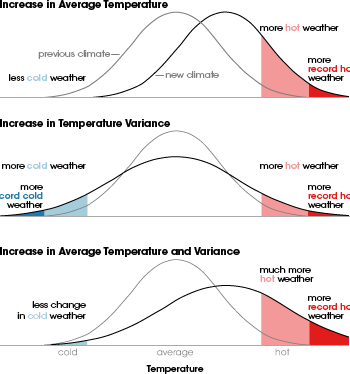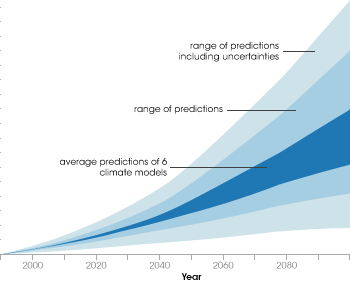

The Impact of Climate Change on Natural Disasters | |||
Climate change may not be responsible for the recent skyrocketing cost of natural disasters, but it is very likely that it will impact future catastrophes. Climate models provide a glimpse of the future, and while they do not agree on all of the details, most models predict a few general trends. First, according to the Intergovernmental Panel on Climate Change, an increase of greenhouse gases in the atmosphere will probably boost temperatures over most land surfaces, though the exact change will vary regionally. More uncertain—but possible—outcomes of an increase in global temperatures include increased risk of drought and increased intensity of storms, including tropical cyclones with higher wind speeds, a wetter Asian monsoon, and, possibly, more intense mid-latitude storms. (For more information, see Global Warming: Potential Effects of Global Warming) |
|||
 |
 |
Changes in climate not only affect average temperatures, but also extreme temperatures, increasing the likelihood of weather-related natural disasters. If global climate change causes the global average temperature to rise (top), there will be less cold weather, and a greater probability of hot and record hot weather. An increase in temperature variability will extend the extremes of temperature, both cold and hot. An increase in average temperature combined with increased variance will have little effect on cold weather, but hot weather will be more common and record hot weather will increase greatly. (Figure adapted from Climate Change 2001: The Scientific Basis) | |
Global warming could affect storm formation by decreasing the temperature difference between the poles and the equator. That temperature difference fuels the mid-latitude storms affect the Earth’s most populated regions. Warmer temperatures could increase the amount of water vapor that enters the atmosphere. The result is a hotter, more humid environment. At the equator, where conditions are already hot and humid, the change isn’t expected to be large. At the poles, however, the air is cold and dry; a little extra heat and water vapor could raise temperatures greatly. As a result, global warming may cause the temperature difference between the poles and the equator to decrease. and as the difference decreases, so should the number of storms, says George Tselioudis, a research scientist at NASA Goddard Institute for Space Studies (GISS) and Columbia University. But even as a warming climate might decrease the overall number of storms that form, it could increase the number of intense storms. As temperatures continue to rise, more and more water vapor could evaporate into the atmosphere, and water vapor is the fuel for storms. “If we are creating an atmosphere more loaded with humidity, any storm that does develop has greater potential to develop into an intense storm,” says Tselioudis. The combined result of increased temperatures over land, decreased equator-versus-pole temperature differences, and increased humidity could be increasingly intense cycles of droughts and floods as more of a region’s precipitation falls in a single large storm rather than a series of small ones. A warmer, wetter atmosphere could also affect tropical storms (hurricanes), but changes to tropical storms are harder to predict and track. Some scientists have speculated that a warmer climate that allows more intense storms to develop would also spawn more hurricanes. Warmer temperatures may also heat ocean waters farther from the Equator, expanding the reach of large tropical storms. But there is little evidence to support the either of these theories, says Kerry Emanuel, a professor of tropical meteorology and climate in the Massachusetts Institute of Technology’s Program in Atmospheres, Oceans, and Climate. The one way in which global warming could impact hurricanes is by making them more intense. More heat and water in the atmosphere and warmer sea surface temperatures could provide more fuel to increase the wind speeds of tropical storms. Warming that has already occurred since 1980 has increased sea surface temperatures 0.3 degrees Celsius, which should increase the maximum potential wind speed of hurricanes by 1 knot, according to hurricane intensity models. But increases that small could not have been observed yet. “At present, hurricane intensity is measured only to an accuracy of plus or minus five knots, so it is not possible to discern any change that might have occurred owing to warming that has already taken place,” says Emanuel. |
|||
 |

Even if tropical storms don’t change significantly, other environmental changes brought on by global warming could make the storms more deadly. Melting glaciers and ice caps will likely cause sea levels to rise, which would make coastal flooding more severe when a storm comes ashore. In their 2001 report, the Intergovernmental Panel on Climate Change stated that global warming should cause sea levels to rise 0.11 to 0.77 meters (0.36 to 2.5 feet) by 2100. |
Scientists use climate models to estimate changes in future sea level rise, one of the expected effects of global warming. This graph shows sea level changes predicted by six climate models, each of which ran 35 different greenhouse gas emission scenarios. The center dark region shows the predicted sea level rise for the models averaged over the 35 emission scenarios. The lighter blue region shows the range of the maximum and minimum model predictions. The outer, lightest blue section includes the uncertainties of land-ice changes, permafrost changes and sediment deposition (not including the possiblity of melting of the West Antarctic Ice Sheet). The top curve is the extreme worst case scenario and the bottom curve shows the least expected change. (Graph adapted from Climate Change 2001: The Scientific Basis) | |